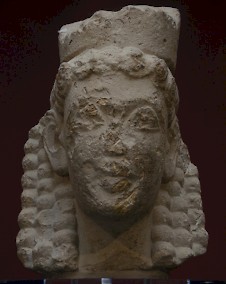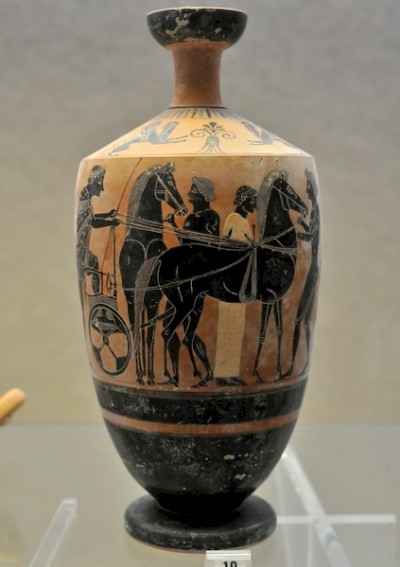History of Syracuse (1)
Q1954223Syracuse: the ancient capital of Sicily.
Colonization and Tyranny

If we are to believe the Athenian historian Thucydides,note the first Greeks to settle on Sicily were from Chalcis on Euboea. In 734, they founded Naxos on a peninsula near the Etna. In the following year, Syracuse was founded by the Corinthian Archias. The name "Syracuse" is said to be derived from the marsh across the Great Harbor, which was reportedly called Syraco, although most sources call it Lysimeleia.
Unfortunately, the great historian does not indicate what he means with "to settle". Was it the first trade contact? A real city? An outpost? Often, Greek colonies were aristocratic in nature, and it has been argued that one of the causes of the Greek wave of colonization was a desire among the Greek nobility to maintain its way of life in an age of change, marked by the rise of nouveaux riches in Greece. Perhaps Syracuse fits this pattern too.
However this may be, Syracuse soon became a town, with a large Temple of Apollo. The oldest building that was identified, was found underneath the modern Muncipio, and appears to date back to the eighth century.
The new town was situated on an island (Ortygia) with a sweet well (Arethusa), which was an excellent base to fight against the native population, which was subjected and reduced to serfdom. The town now expanded to the mainland (Achradina), and new colonies were founded. Acrae (663), Casmenae (643), Camarina (598) and Morgantina (c.560) were agricultural settlements on the fertile coastal plains. The influx of wealth meant that, whatever the original function of Syracuse, the original leaders - often called Gamoroi, "land owners" - found themselves competing to a class of nouveaux riches who could afford the panoply of a hoplite. Everywhere in the Greek world, the consequences were the same: political tensions. In the mid-seventh century, the aristocratic family of the Myletidai was exiled, and founded Himera.

Often, the tensions were solved by the one-man rule of a tyrant, and Sicily was no exception. One of the most famous was Hippocrates of Gela. His mercenaries conquered the eastern part if the island, and when he died in 491/490, he was succeeded as tyrant of Gela by his adjutant Gelon, who added Syracuse. With the support of the town's People's Assembly and the serfs, he expelled the gamoroi class, and became lord of almost every town in eastern Sicily: Gela and Syracuse of course, but also Camarina, Leontini, Catane, Naxos, and several towns of the Siculians. He resettled many people, received back the aristocrats, and made Syracuse, with its excellent harbors, into his capital and one of the most important cities in the Greek world, an equal of Sparta, Miletus, Athens, Corinth, and Thebes. Yet, Gelon was an odd tyrant, because he collaborated with the rich people in his territorial state - tyrants usually found their supporters among the urban poor.
By the end of the 480s, the Carthaginians, who lived on the western part of the island, decided to intervene. They feared Gelon and his ally Theron of Acragas, and when the latter captured Himera, they decided to restore it to its tyrant Terillus. The Carthaginian commander Hamilcar built up a large army and navy in the far west of Sicily and started to besiege Himera. Theron, however, held out and Gelon was able to defeat the Carthaginians decisively in the Battle of Himera. The Greek victory was commemorated by building a large Tempel of Athena in the center of Syracuse (now the Cathedral).

In 478, Gelon died. He was succeeded by his brother Hiero, who continued the policy of resettling people in large cities - Aetna was newly founded and received 10,000 colonists from Syracuse and the Peloponnese - and aggressive interference in foreign affairs. In c.474, he defeated the Etruscans near Cumae and founded a new city on the island Pithecusae, close to Cumae, just outside the Bay of Naples. At the same time, his court became an influential center of Greek culture, visited by poets like Pindar, Bacchylides, Simonides, and Aeschylus. From Sicily itself came Sophron and Epicharmus, and the rhetorician Corax. New momuments were built, like the theater. The victories at Himera and Cumae were heralded as panhellenic triumphs, comparable to the Athenian naval victory at Salamis.
One of the aims of the resettlement of people was to divide the opposition against the tyrants, but in the end, the people united and demanded their share in the political process. In 467, Hiero died, and his brother Thrasybulus found himself expelled. From now on, Syracuse was to be a democracy, the tyrant's mercenary armies were disbanded, and many people who had been resettled now returned to their homes. The revolution, however, also meant that the city lost its grip on the towns it had conquered.
 Syracuse, Gorgo with Pegasus |
 Syracuse, Silenus, dancing with a cup |
 Syracuse, Ionic temple, Sphinx |
 Syracuse, Olpe with sphinxes and a bird (Leontini Painter) |